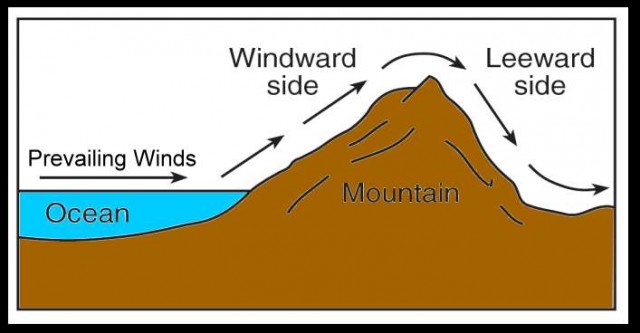leeward and windward
THE TERMS leeward and windward are used in a number of ways to describe specific places, physical features, and climatic processes. In one sense, windward and leeward generally refer to the location of a place relative to the prevailing wind direction. A windward location is one that is exposed to the prevailing winds. Conversely, a leeward location is protected from the prevailing wind.
For example, Concepcion, CHILE, on the west side of the ANDES would be in a windward location relative to westerlies moving inland from the PACIFIC OCEAN simply because it is exposed to the approaching wind. However, the east side of the Andes would be a leeward location because of the protection afforded by the intervening mountains. The windward and leeward designations illustrated here are equally applicable to orographic lifting, the process involved when winds strike the front face of a mountain, are forced up the windward face of the mountain and then descend on the leeward side. If the winds are laden with moisture and the mountain is high enough, the moisture carried by the wind may condense and produce precipitation. The resulting precipitation will in the highest volumes on the windward side of the mountain and the leeward side will invariably receive a lesser amount.

There are a number of places in the world where this process is clearly evidenced. Among them are the moisture-laden westerlies reaching the Pacific coast of WASHINGTON, which are forced aloft by the Coastal Ranges. The windward side of this region receives an abundance of rainfall while the leeward side on the eastern slopes receives little or no rainfall. A classic example of orographic lifting is found in the HIMALAYAS when the summer monsoons bring warm, moist winds across the Indian subcontinent and are then forced aloft by the imposing Himalayan barrier. Areas on the windward side on the mountains may receive as much as 100 in (254 cm) of rainfall. However, because of the great heights of the Himalayas, little or no moisture reaches the leeward side. So within a relatively short distance the climatic results vary from near tropical conditions to the true deserts of Central Asia.
The terms are used in a more formal manner to name particular groups of islands. For example, the islands in the Lesser Antilles in the West Indies all lie in the pathway of the northeast trade winds. This wind belt moves from approximately 30 degrees north latitude toward the equator where it meets its counterpart from the Southern Hemisphere, the southeast trade winds. Historically, British sailing ships entered the region with the northeast trade winds at their backs. The first island encountered on these voyages was usually BARBADOS, the island farthest east and most to windward.
The Windward Islands, as they came to be called, include Barbados, the Caribees (a cluster of small islands), DOMINICA, MARTINIQUE, GRENADA, SAINT LUCIA, and SAINT VINCENT AND THE GRENADINES. The Windward Islands, a former British colony, are the southernmost islands in the Lesser Antilles and were once collectively named the Federal Colony of the Windward Islands and later the Territory of the Windward Islands. The northern continuation of the Lesser Antilles includes islands that are farther downwind from the Windward Islands. First discovered by Columbus in 1493, these are the Leeward Islands, which includes ANTIGUA AND BARBUDA, the British Virgin Islands, MONTSERRAT, SAINT KITTS AND NEVIS, and ANGUILLA. A string of leeward islands is also found northwest of the Hawaiian Islands, and this group has become a national bird sanctuary.
In addition, the Society Islands in French Polynesia, a region east of the COOK ISLANDS in the South Pacific, are identified as leeward islands. Reference may be made as well to another use of the word windward. The narrow sea-lane separating eastern CUBA and HAITI lies in the path of the northeast trade winds. As such, vessels traveling between the ATLANTIC OCEAN and the CARIBBEAN SEA are using the aptly named Windward Passage. Those traveling through the pass from northeast to southwest have the advantage of the northeast trade winds pushing them along.